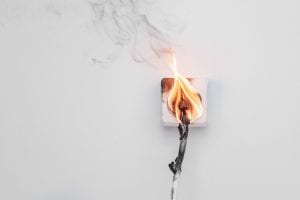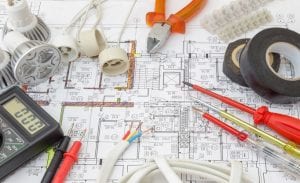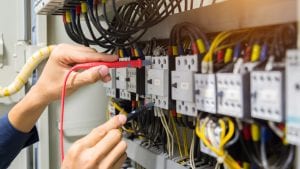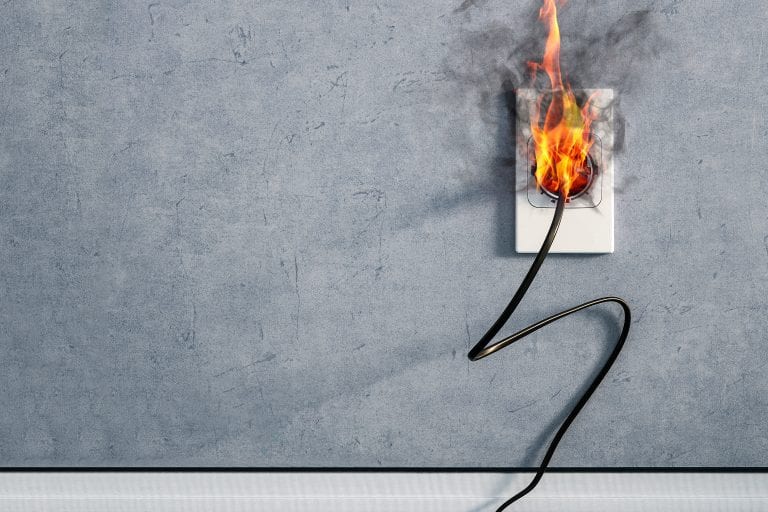Even if you think of yourself as being pretty good with DIY projects, you may want to leave a potential electrical issue to the experts. Anytime there is unsafe wiring, it could cause a fire and severe shock. It’s crucial to understand the hazards and know how to stay safe.
What could cause unsafe wiring?
Not all unsafe wiring is caused by old wiring, but damaged, worn, cracked or corroded wiring can certainly increase the likelihood of an electrical accident. These are a few possibilities:
- Loose connections
- Frayed cords
- Pinched, pierced or cracked wire insulation
- Overheated wires or cords
- Damaged electrical appliances
- Wiring that rodents may have chewed
What about electrical outlets and switches?
You definitely want to keep electrical outlets away from water, as water conducts electricity. Never use a radio, hair dryer, phone or anything else with an electrical cord near water—including pools and wet floors. Never plug damaged or frayed cords into an outlet, either.
How do I know if my wiring is old?
Most homes built before the 1940s used knob and tube wiring, named for the insulating knobs and tubes that ran wiring along and through the building’s frame: one black charged wire and one white neutral wire. Splices and wire connections made with tape placed around ungrounded soldered wires were the norm. The electrical tape insulated them and kept them from touching each other.
Read our other Blogs

Warning Signs of Faulty Electrical Wiring
Faulty wiring can be very dangerous. In the United States, wiring problems are responsible for tens of thousands of house fires every year. Fortunately, the majority of wiring-related accidents could be prevented by inspecting for faulty wiring and fixing it before a major issue emerges. The following faulty electrical wiring signs will help you find

Must-know Tips for DIY Electrical Wiring and Switching
People take on DIY projects in their own homes for a number of reasons. Whether they want to save money, feel more independent or enjoy fixing things themselves, any DIY project requires some basic know-how to be done properly. Installing or replacing electrical switches and wiring is no exception. These DIY Electrical Wiring tips can

Learn the Basics of Home Electrical Wiring
Electrical wiring can be tricky—especially for the novice. That’s why it’s usually best to hire a professional for anything other than a simple job. Otherwise, you could risk injury, damage or fire. If you do plan to complete a DIY project that has an electrical component, there are some basic things to know about wiring
Is old wiring always unsafe, and should I replace it?
Before 1960, wiring insulation was made of rubber that can crumble or flake. It’s dangerous if the insulation has worn away, was installed incorrectly or is covered with regular building insulation material (which could overheat and potentially cause a fire). National Electrical Code (NEC) doesn’t require you to replace knob and tube wiring—especially if you live in a historic home. If local code allows it and your wiring needs work, you can splice the old wiring with new NM (non-metallic) cable if you use a junction box, which protects wire connections.
What if I have a short circuit?
If the power suddenly goes out on an appliance or light or you notice a spark or smoke or smell burning wires, you could have a short circuit. If you suspect a short circuit, turn off the circuit panel, check to see which flip is switched and inspect power cords plugged into outlets along the particular circuit for damage. There are other steps you should take to find a short circuit. If you’ve done the troubleshooting and don’t find an obvious problem, it might be in hidden wiring that an electrician should check out.
The thing about electricity is that it always tries to go back to ground through the wiring circuit breaker panels and then through the utility wires. If the connections within the wiring network loosen or break, current can leak and try to take a shortcut to get to ground. That might mean through flammable material or even you!
Is a short circuit dangerous?
When there’s additional electricity flowing through a switch, outlet or appliance, it generates additional heat. If the affected wires come in contact with flammable parts in your home, they can cause a fire. If you or a pet touches a live or damaged wire or cord, you can get shocked because you both conduct electricity. When the current flows through to the ground, it results in electrical shock.
What a short circuit?
Although there are several possible causes, three are most common:
- Poor circuit wire insulation: If your wiring insulation is old or damaged, a faulty neutral wire connection touching a hot wire can trigger a short circuit.
- Loose wire connections: When attachments loosen, neutral and live wires might touch, creating unsafe wiring that should be repaired by a professional electrician.
- Appliance wiring issues: When you plug an appliance into a wall outlet, the wiring in the cord becomes an extension of the circuit. If the cord has issues, they become circuit issues.

What if I think I know enough to do a wiring job and stay safe?
It’s critical that you make tight electrical connections because if wires loosen, there might be arcing and overheating. That spells potential fire. However, if you make a proper wire nut connection, have reliable terminals and know what else to watch for, it’s possible to make safe connections.
With many electrical wiring projects, you may need to repair the main service panel. That’s the place where utility wires send electricity for distribution throughout the circuits of your home. Again, it’s something that you may be able to do on your own—if you have some electrical experience.
If you know you have unsafe wiring—or even think you may—it’s always better to be safe than sorry. Contact a certified electrician to do the job.
How can I become a certified electrician?
According to O*NETOnLine, the projected job growth for electricians through 2028 is faster than average for other occupations. Have you thought about enrolling in electrician programs in Chicago? Consider taking day and night electrical program classes at Coyne College Chicago. You’ll get the hands-on electrical training and individualized instruction you need to prepare for an in-demand career as an electrician. If you have a day job, Coyne College offers evening electrical classes that could work with your schedule.
Register now for electrical programs at Coyne College.


